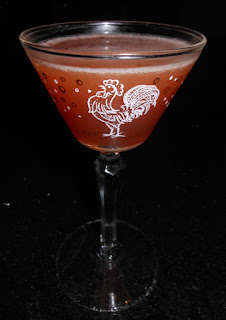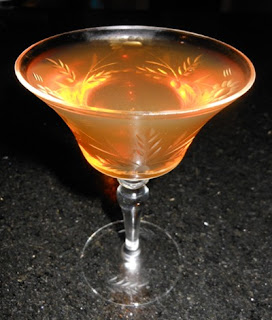1/2 jigger Swedish Punsch (3/4 oz Kronan)
Juice 1/2 Lime (1/2 oz)
Shake with ice and strain into a cocktail glass.


quality versus quantity does not have to be a winner-take-all proposition.

















Hannibal Hamlin (variation)What was exceptionally curious is why two German recipe books have a drink named after a vice president of the United States. Hamlin only served under Lincoln during his first term before being replaced by Andrew Johnson. With Hamlin's poor political record, TIME magazine actually ranked him as one of the worst vice presidents ever. Instead of becoming president after Lincoln was assassinated in the subsequent term, Hamlin spent the time "cavorting around Europe with his wife as a diplomat to Spain, until the age of 75." I surmised that in one of his adventures, he charmed German barmen into naming a drink after him. With a little research, I discovered that Matt Hamlin of A Jigger of Blog spotted the drink's name in a late 19th century list of libations Harry Johnson made at his bar; however, Johnson never left a recipe for it to confirm if either of these two are similar to his. I later discovered that William Schmidt may have recorded the earliest written recipe for this drink in his 1891 The Flowing Bowl:
• 1 1/2 oz Rum
• 1 1/2 oz Cognac
• 1/2 oz Lemon Juice
• 1/2 oz Orange Juice
• 1/3 oz Honey (2 tsp)
Shake with ice and strain into a cocktail glass. From American en Fancy Drinks Ijsrecepten en Dranken by W. Slagter cerca 1920.
Hannibal Hamlin (variation)Given that the Only William's recipe is closer to Slagter's, I have to assume that the Beutel one is a more distant variation.
• Juice 1/2 Lemon
• Juice 1/2 Orange
• 2/3 Peach Brandy
• 1/3 Old Jamaican Rum
• 2 Tbsp Honey
Shake with ice and strain into a fancy glass.


 The theme for this month's Mixology Monday (MxMo LXIV) was picked by Doug Winship of the Pegu Blog. The theme he chose was "Tiki!" which is perfect for February has been Tiki month on his blog for the past few years. Doug described the month's theme as, "The Tiki scene, like classic cocktails in general, is reviving nicely these days. The lush, decadent marriage of tropical flavors and exotic kitsch carries us away to a better, less dreary place. Please join in and add your words, images, and offerings to the Tiki Gods."
The theme for this month's Mixology Monday (MxMo LXIV) was picked by Doug Winship of the Pegu Blog. The theme he chose was "Tiki!" which is perfect for February has been Tiki month on his blog for the past few years. Doug described the month's theme as, "The Tiki scene, like classic cocktails in general, is reviving nicely these days. The lush, decadent marriage of tropical flavors and exotic kitsch carries us away to a better, less dreary place. Please join in and add your words, images, and offerings to the Tiki Gods."Don's Beach PlanterThe Don's Beach Planter began with fruit notes that were accented by fresh lime oils. While the lime and passion fruit flavors filled the sip, the rums and a hint of pineapple came through on the swallow that concluded with spice from the Angostura and absinthe. The combination of the fruits presented an almost mango note and helped to make this drink way too easy to finish.
• 1/2 oz Lime Juice
• 1/2 oz Passion Fruit Syrup (BG Reynolds)
• 1 oz Pineapple Juice
• 1 oz Amber Martinique Rum (JM Rhum)
• 1/4 oz Dark Jamaican Rum (Coruba)
• 1/4 oz Christian Brothers Brandy (Pedro Domecq Fundador Solera Reserva)
• 1 dash Angostura Bitters
• 6 drop (1/8 tsp) Herbsaint or Pernod (Pernod Absinthe)
• 4 oz Crushed Ice
Blend for 5 seconds and pour into a pilsner glass. Fill more crushed ice. Instead of blending, I shook with ice and strained into highball glass filled with crushed ice; I added a straw and garnished with a lime twist.

 1/2 oz Mezcal (Sombra)
1/2 oz Mezcal (Sombra) 1 oz Maurin Quina
1 oz Maurin Quina

 3/4 oz Grappa di Moscato
3/4 oz Grappa di Moscato















A good sherris sack hath a two-fold operation in it. It ascends me into the brain; dries me there all the foolish and dull and curdy vapours which environ it; makes it apprehensive, quick, forgetive, full of nimble fiery and delectable shapes, which, delivered o'er to the voice, the tongue, which is the birth, becomes excellent wit. The second property of your excellent sherris is, the warming of the blood; which, before cold and settled, left the liver white and pale, which is the badge of pusillanimity and cowardice; but the sherris warms it and makes it course from the inwards to the parts extreme: it illumineth the face, which as a beacon gives warning to all the rest of this little kingdom, man, to arm; and then the vital commoners and inland petty spirits muster me all to their captain, the heart, who, great and puffed up with this retinue, doth any deed of courage; and this valour comes of sherris.For a sherry, she chose an oloroso that is described in the article's text as a sweet style of sherry; we lacked a sweet one and used the Lustau Don Nuño Dry Oloroso we had on hand instead. We also split this drink two ways to make for a more moderate-sized nightcap.







 The 2017 collection of 855 drink recipes, bartender tributes, and essays on hospitality from CocktailVirgin's Frederic Yarm. Available at Barnes and Noble and Amazon.
The 2017 collection of 855 drink recipes, bartender tributes, and essays on hospitality from CocktailVirgin's Frederic Yarm. Available at Barnes and Noble and Amazon. The 2012 collection of 505 drink recipes, techniques, and Boston bar recommendations from Frederic Yarm. Available at Amazon and Barnes and Noble.
The 2012 collection of 505 drink recipes, techniques, and Boston bar recommendations from Frederic Yarm. Available at Amazon and Barnes and Noble.